Dear Artist,
Today it’s raining in Chadds Ford, PA. Big drops fall from the ancient sycamores. Off in foggy Brandywine Valley, the witch hazel and pignut hickory still hold their muted colours. Great black trunks narrow down to sharp and random spikes. Cattle wait on the hillsides and solemn crows grumble along an old stone wall. This is Wyeth country.
I’m standing for the first time before the N.C. Wyeth oils in the Brandywine River Museum. I can still inhale the Scribner’s classics of my youth: “Treasure Island,” “Kidnapped,” “The Boy’s King Arthur.” These early paintings are huge. They exude vitality and robustness.
Newell Convers Wyeth (1882-1945), the father of Andrew and grandfather of Jamie, built his home and studio here in 1911 with the proceeds of work done for Scribner’s. He was a pupil of the great illustrator Howard Pyle, who kept a studio and school in nearby Wilmington, Delaware. Wyeth joined him at age 20 and within a year was selling his work to publishers. Pyle’s school was free — he picked and chose his students. Many were to become the godfathers of American illustration.
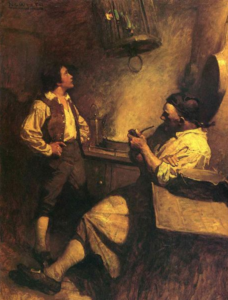
Jim Hawkins, Long John Silver and his Parrot, c. 1911
Illustration from Robert Louis Stevenson’s Treasure Island, published by Charles Scribners, NY, 1911
by N.C. Wyeth
In 1989, Andrew taped a most remarkable conversation about his father. A transcript is available in Three Generations of Wyeth Art published by the museum. It’s a candid and loving portrait about growing up with a sensitive and dynamic dad. It’s also about choosing a creative path of one’s own.
“Some artists get things right with almost no knowledge at all,” says Andrew, “much better than if they go out and search for it. Pa’s best paintings were spontaneous ideas. A concept needs the juice, the essence of the thing, more than all the theory or more knowledge.”
A great reader, N.C. was for the most part self-educated. In consequence, he respected those with a formal education. As his fame grew, critics, publishers, and other artists befriended him. He listened to them and “became agitated.” He was frequently advised to stop painting illustrations and make “real” art. “Pa made many dramatic changes in his life; reacting to specific artists,” says Andrew. “Even my influence was not good for him. My father lost his excitement for painting. He lost the vitality.”
Best regards,
Robert
PS: “‘Treasure Island’ is completed! The entire set of seventeen canvases without one break in my enthusiasm and spirit. Better in every quality than anything I ever did.” (N.C. Wyeth, age 29, in a letter to his mother, July 26, 1911)
Esoterica: N.C. was an energetic, driven painter who learned fast with the help of Pyle. He drew basic elements in charcoal with little recourse to models, with the exception of hands. A believer in big brushes and big gobs on his palette, N.C. Wyeth came to understand early on that speed itself enhanced freshness. Andrew reports that the painting “Train Robbery,” was painted from scratch in a single morning.
This letter was originally published as “What happens?” on October 27, 2009.
Have you considered a Premium Artist Listing? With each letter, an artist is featured at the bottom of this page. The Premium Artist Listings are a means of connecting artist subscribers through their work. Proceeds from each listing contribute to the production of The Painter’s Keys.
“If you paint a man leaning over, your own back must ache.” (N. C. Wyeth)
Featured Workshop
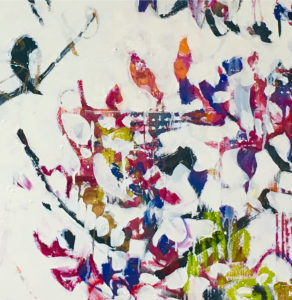 Join Ellie Harold for “Intuitive Painting: Permission to Paint Expressively,” designed especially for mature women artists of all skill levels who wish to explore this medium for soulful exploration. The retreat provides attractive accommodations (your own room!) along with lightly structured activities for centering, relaxation and low stress art-making. You’ll have plenty of free time to muse, paint, write and reflect while enjoying the colors, textures and flavors of San Miguel. This Retreat has the potential to transform not only your art but your life! You’ll return home with a specific art “care plan” to assure support for further creating. Details at www.EllieHarold.com.
Join Ellie Harold for “Intuitive Painting: Permission to Paint Expressively,” designed especially for mature women artists of all skill levels who wish to explore this medium for soulful exploration. The retreat provides attractive accommodations (your own room!) along with lightly structured activities for centering, relaxation and low stress art-making. You’ll have plenty of free time to muse, paint, write and reflect while enjoying the colors, textures and flavors of San Miguel. This Retreat has the potential to transform not only your art but your life! You’ll return home with a specific art “care plan” to assure support for further creating. Details at www.EllieHarold.com.

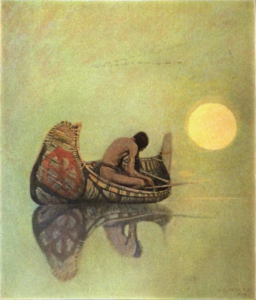
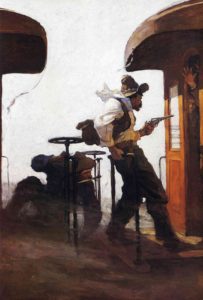
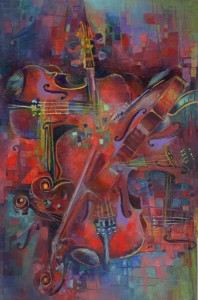



11 Comments
Sara,
Your father’s book will be a treasure for us who are seeking to learn how to paint. I am looking forward to its publication. Thank you for sharing the truthful quotes from his wisdom.
I have owned his book (collected letters) for years and consider it my favorite art book of all I have ever owned, including a close 2nd: Harley Brown’s what every artist should know (or some similar title). I’ve underlined most of every page of Robert’s book (and there are a thousand pages!!!). A treasure trove of knowledge and wisdom unlike any other.
BTW, firemen are educated by being shown videos of what happens when firemen do the wrong thing, because the negative is retained. Which explains why we remember the criticisms and don’t value the compliments enough.
Dear Sara,
Another gem of a letter. Myself, coming from a design background, where I had trouble curbing my painterly enthusiasm, have had some difficulty finding my path back to spontaneity. Getting advice from everybody and trying to paint like them is deadly.
I feel like an outsider trying to find my own way into painting. I hope at 75 I still have a chance to get there.
all the best,
Mary Jean,
You echo my thoughts exactly! Let’s vow to take no more instruction and pay attention to our idle doodlings. I wish us both luck in finding joy in both our art direction and in our love of design.
Margot
I often ponder why we tend to believe those who offer criticism over those who give positive compliments. I look back on years of feeling agitated, hard to recall feeling truly encouraged. I mean, I am sure I was, but those moments of encouragement didn’t stick to the sides of the pot like the negative comments did. Sad to think NC who gave the world
such beautiful artwork born from his inspired soul fell victim to agitation and loss of enthusiasm due to what others thought. But I so get that, safest just to do this thing called making art on our own.
I for one am, as the saying goes, my own worst enemy, my own worst critic. So I tend not to believe positive comments if I am not happy with what I’ve done. On the other hand, years ago, when my husband told me I’d painted a palm tree wrong, I told him to draw me what he thought it should look like. (He grew up in Hawaii so he should know, right?) He said, “Oh, I can’t draw”. After that I told him if he wants a perfect palm (or anything), go take a picture of one; I am not replicating, I am creating. He’s not allowed to volunteer any criticisms of my art, and in fact began to realize the challenges and recognize art for what it really is: a literal expression of one’s spirit and ability.
Hi Sara. Thanks again for another inspiring letter. I, too, was saddened to hear that N.C. Wyeth had succumbed to other’s advice for him. I was surprised by what Andrew Wyeth said in those interviews. That his father had such a passion for his painting and illustrations when he was young. And they were masterpieces! Then, other people who he thought he should trust, told him he shouldn’t “just” be an illustrator. But,that he should work on more “serious” paintings. The fact that their advice agitated and confused him, were signs that their advice wasn’t for him, and that he should stand strong in what he was doing. But, that is one of the heartbreaks in life. When you don’t yet have confidence in who you are, and you take advice that leads you off the path you are meant to be on. But, thankfully, N.C. Wyeth did a number of paintings and illustrations that are so beautiful. And, that can be enjoyed in books such as Treasure Island, or going to the Brandywine Museum, and seeing the paintings, up close and personal. The bonus is, you get to see the paintings of his son, Andrew and grandson Jamie, as well.
I remember as a boy, reading the books and stories illustrated by N.C. Wyeth. Those remarkable pieces of art made the stories come alive! Looking with an artist’s eye today, I can see the qualities and characteristics in so many of them that make them great art.
They are still exciting to see!
What a beautifully evocative description of the Brandywine Valley and its connection escape road to the Wyeth legacy. The imagery of the landscape, paired with the rich history of N.C.
Chill Girl clicker
This letter really captured the spirit and vitality in N.C. Wyeth’s paintings. The way nature and human expression intertwine is fascinating and inspiring. Stories like this always give me a boost of creativity. On the other hand, playing basketball legends helps me shake off daily stress. Just taking a short break and diving into the game clears my mind and makes me feel refreshed.